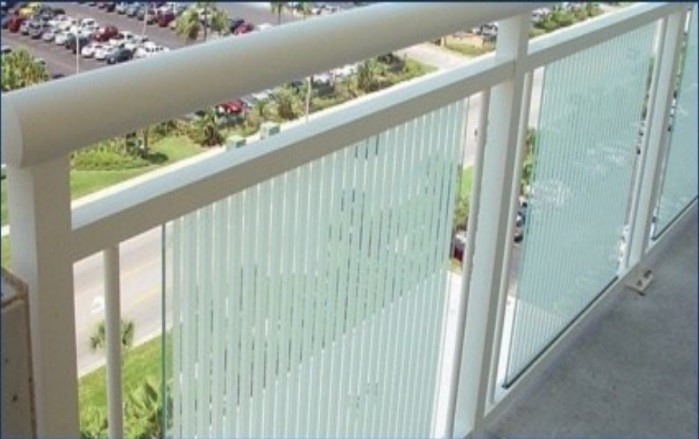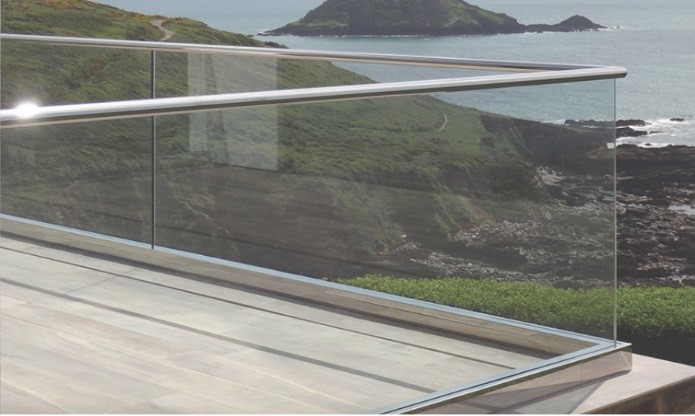Aesthetically pleasing, clean and one of the biggest architectural trends, the glass railing is fast gaining popularity as a go-to safeguard barrier for modern construction. It’s not only a widely used structural component for safeguard applications, but one with many variables and configurations that changes the way that they need to be analyzed in order to provide the level of safety that is required by code.
There are 2 main installation types to be considered when determining the need for a top rail.
Glass railing with top rails supported by post
This design treats glass as an infill, and the structural support for the loads-imposed relays on the top rail and the  vertical post. In Florida railings shall comply Section 2407 of the FLORIDA BUILDING CODE SEVENTH EDITION (2020). Similarly, the 2015/18 International Building Code has section 2407 as well. Glazing infill on this type of railings must conform with section 2406.1.1 (of FBC 2017) for installations outside the wind-borne debris regions and with section 2407.1.4 for railings located in the wind-borne debris regions.
vertical post. In Florida railings shall comply Section 2407 of the FLORIDA BUILDING CODE SEVENTH EDITION (2020). Similarly, the 2015/18 International Building Code has section 2407 as well. Glazing infill on this type of railings must conform with section 2406.1.1 (of FBC 2017) for installations outside the wind-borne debris regions and with section 2407.1.4 for railings located in the wind-borne debris regions.
ANSWER: The top rail cannot be removed under this condition.
Glass railing with top rails supported by glass
On these railing systems, the main structural member is the glass baluster,  and per section 2407.1.2 (FBC/IBC) the top rail shall be supported at least by 3 glass panels or otherwise so it remains in place in the case that one baluster panel fails, nonetheless the code also provides an exception to the rule where laminated glass is proportioned and is subject to the building official approval, in all of this cases the glass shall comply with all the load requirements from section 1607.8 (IBC / FBC) . and special attention is required for the glass deflection in order to avoid an entrapment hazard.
and per section 2407.1.2 (FBC/IBC) the top rail shall be supported at least by 3 glass panels or otherwise so it remains in place in the case that one baluster panel fails, nonetheless the code also provides an exception to the rule where laminated glass is proportioned and is subject to the building official approval, in all of this cases the glass shall comply with all the load requirements from section 1607.8 (IBC / FBC) . and special attention is required for the glass deflection in order to avoid an entrapment hazard.
These conditions are only acceptable outside the wind-borne debris region in Florida when testing on the railing has not been conducted.

When railing is located on the wind-borne debris region testing must be conducted per requirements of section 1609.1.2 and for systems installed on the Florida HVHZ (Dade and Broward Counties), testing shall be conducted per FBC 1618.4.6.4 , and ultimately it is up to the authority having jurisdiction to approve this installations on a site specific basis.
OUR TIP: Some municipalities like Miami – Dade have checklist on their web sites with the minimum requirements for this system to be approved or minimum requirements for testing.
RESULT: When can the top rail be removed?
- Railing must not be located on the HVHZ, the glass baluster shall be made of laminated glass and installations shall be approved by building official on a site-specific basis.
It is always at the building official’s discretion to approve if a glass railing to be installed without a top rail. At the end of the day this is a major structural component for the system, it allows to the glass panels or posts to distribute the loads, reduce deflections on the system and provide an additional safety layer in the case of a glass failure. We recommend discussing your situation with the building official or Contacting Us to assist in your custom need for expert consultation.
Last Update: March 31, 2022
